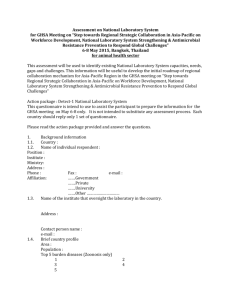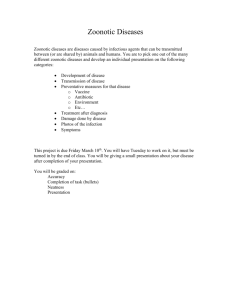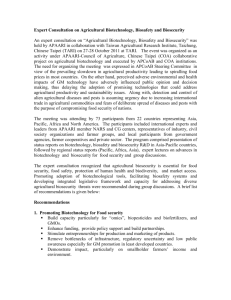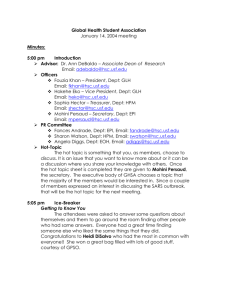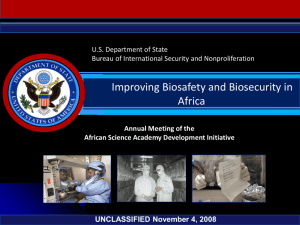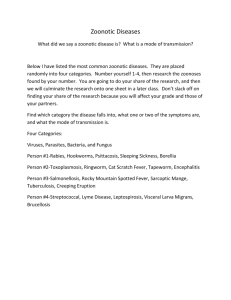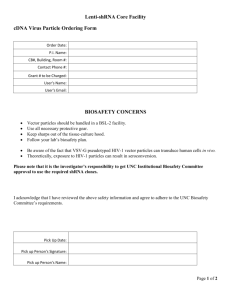Presentation: Global Health Security Overview
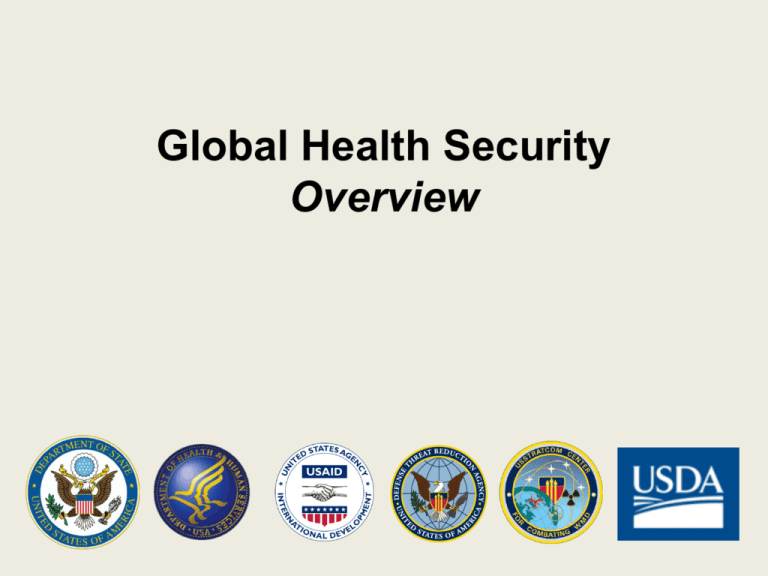
Global Health Security
Overview
9 Lessons We Should Learn From the Ebola Epidemic
• Mounting a response after the onset of human-to-human transmission leaves the world vulnerable • "Events" once local can rapidly become global • Weak (health) infrastructure anywhere poses a threat everywhere • Early recognition of a potential threat allows for a global effort to take pre-emptive steps
9 Lessons We Should Learn From the Ebola Epidemic
• Ebola, like three-quarters of all emerging disease threats, arises from animal reservoirs • Most new microbes from wildlife come from bats, rodents, non-human primates • Good infection control practices are essential • A strong public health workforce, including trained field epidemiologists, is needed • Laboratory systems and basic laboratory infrastructure needs strengthening
GHSA and the Ebola Outbreak
Provide infection-control education and supplies
Prevent
Provide guidance for behavioral change, including safe burial methods Establish biosafety and biosecurity protocols Improve systems for disease reporting
Detect
Provide diagnostics and transport systems for specimens Hire and train personnel to manage outbreak detection and response Establish and staff emergency operations centers
Respond
Establish isolation and treatment centers Provide personal protective equipment, logistic support, and essential supplies
Adapted from Frieden et al., NEJM 2014 Aug 20.
Human and Animal Disease Reporting for Global Health Protection
• GHSA builds country capacity to support achievement of IHR and WAHIS reporting requirements/standards. • Global Health Security – “...the activities required, both proactive and reactive, to minimize vulnerability to acute public health events that endanger the collective health of populations living across geographical regions and international boundaries” (World Health Assembly Report, 2007) • In 2003, SARS cost $30 billion in only 4 months • The anthrax attacks of 2001 infected 22 people, killed 5, and cost more than $1 billion to clean up • The 2009 H1N1 influenza pandemic killed 284,000 people in its first year alone • AIDS spread silently for decades
Less than 20% of the world is prepared to respond
• All 194 countries of the world committed to International Health Regulations • June 2012 deadline – only 16% fully prepared to detect and respond to pandemics
Global Health Security
3
Risks
• Emerging organisms • Drug resistance • Intentional creation
3
Opportunities
• Public health framework • New lab and surveillance tools • Successful outbreak control
3
© David Snyder/CDC Foundation
Priorities
• Prevent wherever possible • Detect rapidly • Respond effectively
U.S. Government GHS Landscape
Department of Health and Human Services
Office of Global Affairs; Office of the Assistant Secretary for Preparedness and Response; CDC; Food and Drug Administration
Department of State
Biosecurity Engagement Program (BEP); Office of International Health and Biosecurity; Biological Policy Office
U.S. Agency for International Development
Emerging Pandemic Threats Program
Department of Defense
Office of the Assistant Secretary for Global Affairs; Office of the Assistant Secretary for Nuclear, Chemical, and Biological Defense Programs; Defense Threat Reduction Agency (DTRA); Armed Forces Health Surveillance Center
Department of Agriculture
Foreign Agriculture Services, Animal and Plant Health Inspection Service, Agricultural Research Service
Global Commitment
Nearly 40 countries have joined Joint development of capacity targets Endorsed by the G-7 in June 2014 Steering Committee includes ten nations plus WHO, FAO, OIE Shared technical leadership 4 billion people in at least 30 countries to be protected
Global Health Security Agenda Timeline
Making the world safer for 4 billion people
Less than 20% of countries fully prepared 2012 2013 CDC/DOD expansion of GHS projects in 12 countries Countries commit to GHSA Action Packages 2014 2015 4 billion people in at least 30 countries are protected By 2020 USAID/DOD collaboration around AI and EPT Successful GHS Demonstration Projects in 2 countries Expansion of GHS activities with anticipated appropriations
Prevent Detect Respond
GHSA Objectives
Prevent the emergence and spread of antimicrobial drug resistant organisms and emerging zoonotic diseases, and strengthen international regulatory frameworks governing food safety. Promote national biosafety and biosecurity systems. Reduce the number and magnitude of infectious disease outbreaks.
Launch, strengthen and link global networks for real-time
biosurveillance.
Strengthen the global norm of rapid, transparent reporting and sample sharing. Develop and deploy novel diagnostics and strengthen laboratory systems. Train and deploy an effective disease surveillance workforce.
Develop an interconnected global network of Emergency Operations Centers and multi-sectoral response to biological incidents. Improve global access to medical and non-medical countermeasures during health emergencies.
Global Health Security Agenda a Multi-sectoral approach
• • • • • • • • • • • Human Health Animal Health Environment Agriculture Food Security Economic Growth Education Humanitarian Assistance National Security Foreign Affairs Defense
CDC GHSA Technical Areas
GHSA Technical Area Biosafety & Biosecurity Antimicrobial Resistance Description
• Promoting national biosafety and biosecurity systems and establishing bio-risk management training to sustain best practices • Preventing the emergence and spread of antimicrobial resistant pathogens, including drug-resistant bacteria
Zoonotic Diseases Immunization Surveillance Systems
• Preventing the emergence and spread of zoonotic diseases • Effective protection through immunization against measles and other epidemic-prone diseases • Strengthening national and international surveillance systems to detect emerging public health threats
Laboratory Systems
• Developing a nationwide laboratory system and deploying diagnostic approaches.
CDC GHSA Technical Areas
GHSA Technical Areas Information Systems (Linking and Reporting) Description
• Developing and linking real-time biosurveillance networks • Strengthening capabilities for rapid reporting to the WHO during emergencies
Workforce Development
• Training and deploying an effective biosurveillance workforce
Emergency Management Medical Counter Measures & Personnel Deployment
• Enhancing Emergency Operations Center capacity and conducting a rapid and effective multi-sectoral response to contain and mitigate public health threats • Strengthening international infrastructure, policies, and operational frameworks for the deployment of public health and medical personnel internationally in response to emergencies.
Linking Public Health & Law Enforcement
• Building linkages between health and law enforcement for the purpose of attribution of bioweapon attacks
2013 GHSA Demo Successes
South Africa
• Conducted a biothreat and vulnerability assessment at the biobank/laboratory in Skukuza to identify opportunities for biosafety and biosecurity upgrades
India
• Provided microbiological lab training for detection of selected priority enteric pathogens in 4 districts of 2 states. • Immediately following training, interventions to improve cholera diagnostics
Vietnam
• Established a regional animal zoonotic disease station in a rural province north of Hanoi, which will serve as the hub for all animal rabies surveillance activities in the Phu Tho province .
Uganda
• • • Surveillance that covers all reportable diseases in >50% of districts Upgrade public health labs to meet accreditation Improve EOC with staffing and technology
Tanzania GHSA Planning
Tanzania owned Existing GHSA activities 5 year roadmap 18 month work plan Engage other partners
Information
• IHR implementation plan 2014-2016 • Ebola Preparedness Plan • One Health Strategy • Cooperative Agreements • Our partnerships
Planning Principles
Be realistic Build off of what exists Align with Tanzanian priorities Play to our strengths
Priority Technical Areas
GHSA Technical Areas Surveillance Systems Information Systems (Linking and Reporting) Workforce Development Description
• Strengthening national and international surveillance systems to detect emerging public health threats • Developing and linking real-time biosurveillance networks • Strengthening capabilities for rapid reporting to the WHO during emergencies • Training and deploying an effective biosurveillance workforce
Biosafety & Biosecurity Laboratory Systems Zoonotic Diseases
• Promoting national biosafety and biosecurity systems and establishing bio-risk management training to sustain best practices • Developing a nationwide laboratory system and deploying diagnostic approaches. • Preventing the emergence and spread of zoonotic diseases
The Global Health Security Agenda (GHSA)
“ …We must come together to prevent, and detect and fight every kind of biological danger – whether it’s a pandemic like H1N1, a terrorist threat, or a treatable disease.”
President Barack Obama, 2011
